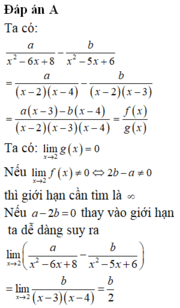

Hãy nhập câu hỏi của bạn vào đây, nếu là tài khoản VIP, bạn sẽ được ưu tiên trả lời.



heo me tim gtnn gtln cua bieu thuc:asinx + bcosx (a,b la hang so,a^2+b^2=/o)? | Yahoo Hỏi & Đáp

lim (x-->0) \(\frac{\sqrt[3]{ax+1}-\sqrt{1-bx}}{x}=2\)
<=> lim ( x-->0) \(\left(\frac{\sqrt[3]{ax+1}-1}{x}+\frac{1-\sqrt{1-bx}}{x}\right)=2\)
<=> lim (x-->0)\(\left(\frac{a}{\sqrt[3]{\left(ax+1\right)^2}+\sqrt[3]{ax+1}+1}+\frac{b}{\sqrt{1-bx}+1}\right)=2\)
<=> \(\frac{a}{3}+\frac{b}{2}=2\)
mà a + 3b = 3
=> a= 3; b = 2
=> A là đáp án sai.

Bài 1:
\(\lim\limits _{x\to 1}\frac{4x^6-5x^5+x}{(1-x)^2}=\lim\limits _{x\to 1}\frac{x(x-1)^2(4x^3+3x^2+2x+1)}{(1-x)^2}\)
\(=\lim\limits _{x\to 1}x(4x^3+3x^2+2x+1)=1(4.1^3+3.1^2+2.1+1)=10\)
Bài 3:
\(\lim\limits _{x\to +\infty}[\sqrt{9x^2-4x+3}-(ax+b)]=0\)
\(\Rightarrow \lim\limits _{x\to +\infty}\frac{\sqrt{9x^2-4x+3}-(ax+b)}{x}=0\)
\(\Leftrightarrow \lim\limits _{x\to +\infty}\left(\sqrt{9-\frac{4}{x}+\frac{3}{x^2}}-a+\frac{b}{x}\right)=0\)
\(\Leftrightarrow a=3\)
Thay $a=3$ vào đk ban đầu:
\(\lim\limits _{x\to +\infty}[\sqrt{9x^2-4x+3}-3x-b]=0\)
\(\Leftrightarrow \lim\limits _{x\to +\infty} (\sqrt{9x^2-4x+3}-3x)=b\)
\(\Leftrightarrow \lim\limits _{x\to +\infty}\frac{-4x+3}{\sqrt{9x^2-4x+3}+3x}=b\)
\(\Leftrightarrow \lim\limits _{x\to +\infty}\frac{-4+\frac{3}{x}}{\sqrt{9-\frac{4}{x}+\frac{3}{x}}+3}=b\)
\(\Leftrightarrow \frac{-4}{6}=b\Leftrightarrow b=-\frac{2}{3}\)

\(\lim\limits_{x\rightarrow3}\frac{2\left(\sqrt{x+1}-2\right)}{x-3}=\lim\limits_{x\rightarrow3}\frac{2\left(\sqrt{x+1}-2\right)\left(\sqrt{x+1}+2\right)}{\left(x-3\right)\left(\sqrt{x+1}+2\right)}=\lim\limits_{x\rightarrow3}\frac{2\left(x-3\right)}{\left(x-3\right)\left(\sqrt{x+1}+2\right)}\)
\(=\lim\limits_{x\rightarrow3}\frac{2}{\sqrt{x+1}+2}=\frac{2}{4}=\frac{1}{2}\)

\(\lim\limits_{x\rightarrow0}\frac{\sqrt{3x+1}-1}{x}=\lim\limits_{x\rightarrow0}\frac{3x}{x\left(\sqrt{3x+1}+1\right)}=\lim\limits_{x\rightarrow0}\frac{3}{\sqrt{3x+1}+1}=\frac{3}{2}\)
\(\Rightarrow a^2+b^2=3^2+2^2=13\)

Nếu
\(\lim\limits_{x\rightarrow+\infty}\left(\sqrt{x^2+x+1}-2\sqrt{x^2-x+1}\right)=\lim\limits_{x\rightarrow+\infty}x\left(\sqrt{1+\frac{1}{x}+\frac{1}{x^2}}-2\sqrt{1-\frac{1}{x}+\frac{1}{x^2}}\right)\)
\(=+\infty.\left(1-2\right)=-\infty\)
Nếu:
\(\lim\limits_{x\rightarrow-\infty}\left(\sqrt{x^2+x+1}-2\sqrt{x^2-x+1}\right)=\lim\limits_{x\rightarrow-\infty}x\left(-\sqrt{1+\frac{1}{x}+\frac{1}{x^2}}+2\sqrt{1-\frac{1}{x}+\frac{1}{x^2}}\right)\)
\(=-\infty.\left(-1+2\right)=-\infty\)

3.
\(x-2y+1=0\Leftrightarrow y=\frac{1}{2}x+\frac{1}{2}\)
\(y'=\frac{2}{\left(x+1\right)^2}\Rightarrow\frac{2}{\left(x+1\right)^2}=\frac{1}{2}\)
\(\Rightarrow\left(x+1\right)^2=4\Rightarrow\left[{}\begin{matrix}x=1\Rightarrow y=1\\x=-3\Rightarrow y=3\end{matrix}\right.\)
Có 2 tiếp tuyến: \(\left[{}\begin{matrix}y=\frac{1}{2}\left(x-1\right)+1\\y=\frac{1}{2}\left(x+3\right)+3\end{matrix}\right.\) \(\Leftrightarrow\left[{}\begin{matrix}y=\frac{1}{2}x+\frac{1}{2}\left(l\right)\\y=\frac{1}{2}x+\frac{9}{2}\end{matrix}\right.\)
4.
\(\lim\limits\frac{\sqrt{2n^2+1}-3n}{n+2}=\lim\limits\frac{\sqrt{2+\frac{1}{n^2}}-3}{1+\frac{2}{n}}=\sqrt{2}-3\)
\(\Rightarrow\left\{{}\begin{matrix}a=2\\b=3\end{matrix}\right.\)
5.
\(\lim\limits_{x\rightarrow a}\frac{2\left(x^2-a^2\right)+a\left(a+1\right)-\left(a+1\right)x}{\left(x-a\right)\left(x+a\right)}=\lim\limits_{x\rightarrow a}\frac{\left(x-a\right)\left(2x+2a\right)-\left(a+1\right)\left(x-a\right)}{\left(x-a\right)\left(x+a\right)}\)
\(=\lim\limits_{x\rightarrow a}\frac{\left(x-a\right)\left(2x+a-1\right)}{\left(x-a\right)\left(x+a\right)}=\lim\limits_{x\rightarrow a}\frac{2x+a-1}{x+a}=\frac{3a-1}{2a}\)
1.
\(f'\left(x\right)=-3x^2+6mx-12=3\left(-x^2+2mx-4\right)=3g\left(x\right)\)
Để \(f'\left(x\right)\le0\) \(\forall x\in R\) \(\Leftrightarrow g\left(x\right)\le0;\forall x\in R\)
\(\Leftrightarrow\Delta'=m^2-4\le0\Rightarrow-2\le m\le2\)
\(\Rightarrow m=\left\{-1;0;1;2\right\}\)
2.
\(f'\left(x\right)=\frac{m^2-20}{\left(2x+m\right)^2}\)
Để \(f'\left(x\right)< 0;\forall x\in\left(0;2\right)\)
\(\Leftrightarrow\left\{{}\begin{matrix}m^2-20< 0\\\left[{}\begin{matrix}m>0\\m< -4\end{matrix}\right.\end{matrix}\right.\) \(\Leftrightarrow\left\{{}\begin{matrix}-\sqrt{20}< m< \sqrt{20}\\\left[{}\begin{matrix}m>0\\m< -4\end{matrix}\right.\end{matrix}\right.\)
\(\Rightarrow m=\left\{1;2;3;4\right\}\)